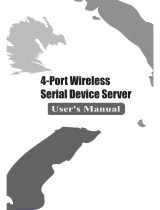
MiiNePort E1/E2-SDK Introduction
Table of Contents
1. Introduction ...................................................................................................................................... 1-1
Overview ........................................................................................................................................... 1-2
Package Checklist ............................................................................................................................... 1-2
Product Features ................................................................................................................................ 1-2
Panel Layout ...................................................................................................................................... 1-3
MiiNePort E1-SDK Evaluation Board Panel Layout ............................................................................ 1-3
MiiNePort E2-SDK Evaluation Board Panel Layout ............................................................................ 1-4
Block Diagram .................................................................................................................................... 1-5
For MiiNePort E1-SDK Module ....................................................................................................... 1-5
For MiiNePort E2-SDK Module ....................................................................................................... 1-6
LED Indicators .................................................................................................................................... 1-6
2. Getting Started.................................................................................................................................. 2-1
Wiring Precautions .............................................................................................................................. 2-2
Selecting the Serial Interface ............................................................................................................... 2-2
Connecting Power ............................................................................................................................... 2-3
Connecting MiiNePort USB to PC ........................................................................................................... 2-3
Connecting to the Network ................................................................................................................... 2-5
Connecting to a Serial Device ............................................................................................................... 2-5
Digital I/O Channel Settings ................................................................................................................. 2-5
Schematic Design Guide ...................................................................................................................... 2-6
3. Choosing the Proper Operation Mode ................................................................................................ 3-1
Overview ........................................................................................................................................... 3-2
RealCOM Mode ................................................................................................................................... 3-2
Ethernet Modem Mode ......................................................................................................................... 3-3
4. Utility Console and Driver Installation .............................................................................................. 4-1
Device Search Utility (DSU) ................................................................................................................. 4-2
Installing the Device Search Utility ................................................................................................ 4-2
Device Search Utility Configuration ................................................................................................ 4-4
NPort Windows Driver Manager ............................................................................................................ 4-5
Installing NPort Windows Driver Manager ....................................................................................... 4-5
Using NPort Windows Driver Manager ............................................................................................ 4-7
Command Line Installation/Removal .............................................................................................. 4-9
Linux Real TTY Drivers ...................................................................................................................... 4-11
Installing Linux Real TTY Driver Files ................................................................................................... 4-11
Mapping TTY Ports ..................................................................................................................... 4-11
Removing Mapped TTY Ports ....................................................................................................... 4-12
Removing Linux Driver Files ........................................................................................................ 4-12
UNIX Fixed TTY Drivers ..................................................................................................................... 4-12
Installing the UNIX Driver........................................................................................................... 4-13
Configuring the UNIX Driver ....................................................................................................... 4-13
5. MiiNePort IDE Development Tool ...................................................................................................... 5-1
Installing MiiNePort IDE ....................................................................................................................... 5-2
Starting MiiNePort IDE ......................................................................................................................... 5-6
Create MiiNePort-SDK Project ............................................................................................................... 5-6
RealCOM Mode ............................................................................................................................ 5-8
Ethernet Modem Mode ................................................................................................................. 5-9
Sample Application .................................................................................................................... 5-10
Data Packing ............................................................................................................................ 5-11
Serial Command Mode ............................................................................................................... 5-13
Web Console ............................................................................................................................. 5-17
CLI .......................................................................................................................................... 5-18
SNMP agent .............................................................................................................................. 5-18
TFTP Server .............................................................................................................................. 5-19
NTP Client ................................................................................................................................ 5-19
CPU Monitor.............................................................................................................................. 5-20
Wizards ........................................................................................................................................... 5-21
Modify project dependency ......................................................................................................... 5-21
CLI Wizard ............................................................................................................................... 5-21
Configuration Wizard ................................................................................................................. 5-24
SCM Wizard .............................................................................................................................. 5-26
SNMP Wizard ............................................................................................................................ 5-28
User App Wizard ....................................................................................................................... 5-31
Build project ............................................................................................................................. 5-32
Upload debug version firmware to MiiNePort ................................................................................. 5-32
Debug current active project ....................................................................................................... 5-32
Upload your customized firmware to MiiNePort .............................................................................. 5-32


























